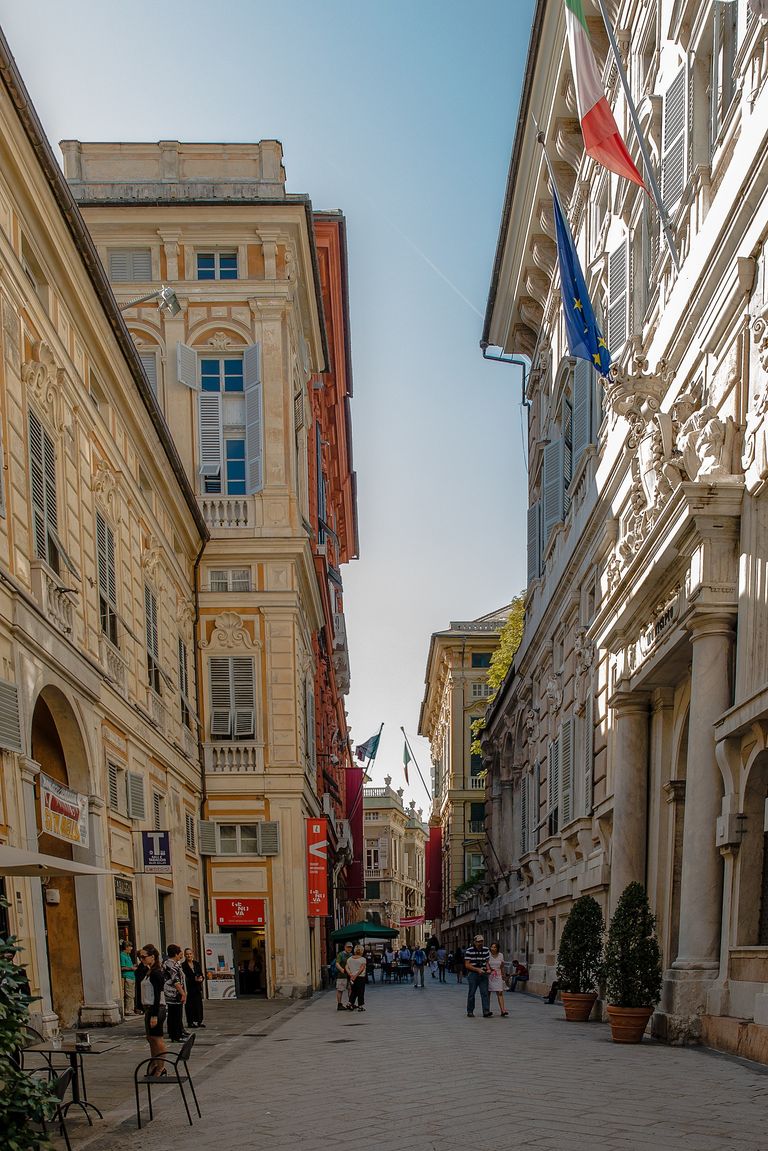
I continue with this sort of guided tour through the streets of Genoa, the city where I spent 20 years of my life, that is to say the end of my childhood and all my adolescence.
A city from which I am currently separated by more than 10,000 kms but which I will always keep in my heart.
In previous posts I told you about the Lanterna, the lighthouse, symbol of the city, about Boccadasse, the district on the sea with its multicoloured houses, about the Galata naval museum, the largest in the world, in a city whose origins were always seafaring, about the monumental Cathedral of San Lorenzo, located in the very heart of the city, nestled in the very heart of the historic centre, the largest and most densely populated in Europe, and the Doge's Palace, emblem of Genoese power at a time when a large part of Liguria was independent of the central power, forming an autonomously administered Republic.
Today I am going to share with all the #blurtians readers of this blog my impressions of Via Garibaldi and one of its emblematic buildings: the Rolli palace.
Via Garibaldi and the Palazzi dei Rolli / Via Garibaldi and the Palazzi dei Rolli.

Sigo con esta especie de visita guida por las calles de Genova, ciudad en la que pasé 20 años de mi vida, es decir el final de mi infancia y toda mi adolescencia.
Una ciudad de la cuál estoy separada actualmente por más de 10.000 kms pero que conservo siempre en mi corazón.
En posts anteriores les hablé de la Lanterna, es decir el faro, símbolo de la ciudad, de Boccadasse el barrio sobre el mar con las casas multicolores, de museo naval Galata, el más grande del mundo, en una ciudad cuyos orígenes fueron siempre marineros, de la monumental Catedral de San Lorenzo, enclavada en el mismo corazón del Centro Histórico, el más grande y densamente poblado de toda Europa, y del Palacio Ducal, emblema del poder genovés de esa época en la cual gran parte de la Liguria era independiente del poder central formando una Repéblica que se administraba autónomamente.
Hoy voy a compartir con todos los #blurtians lectores de este blog mis impresiones sobre la calle Garibaldi y uno de sus edificios emblema: el palacio de los Rolli.
Via Garibaldi and the Palazzi dei Rolli / Via Garibaldi y los Palazzi dei Rolli.
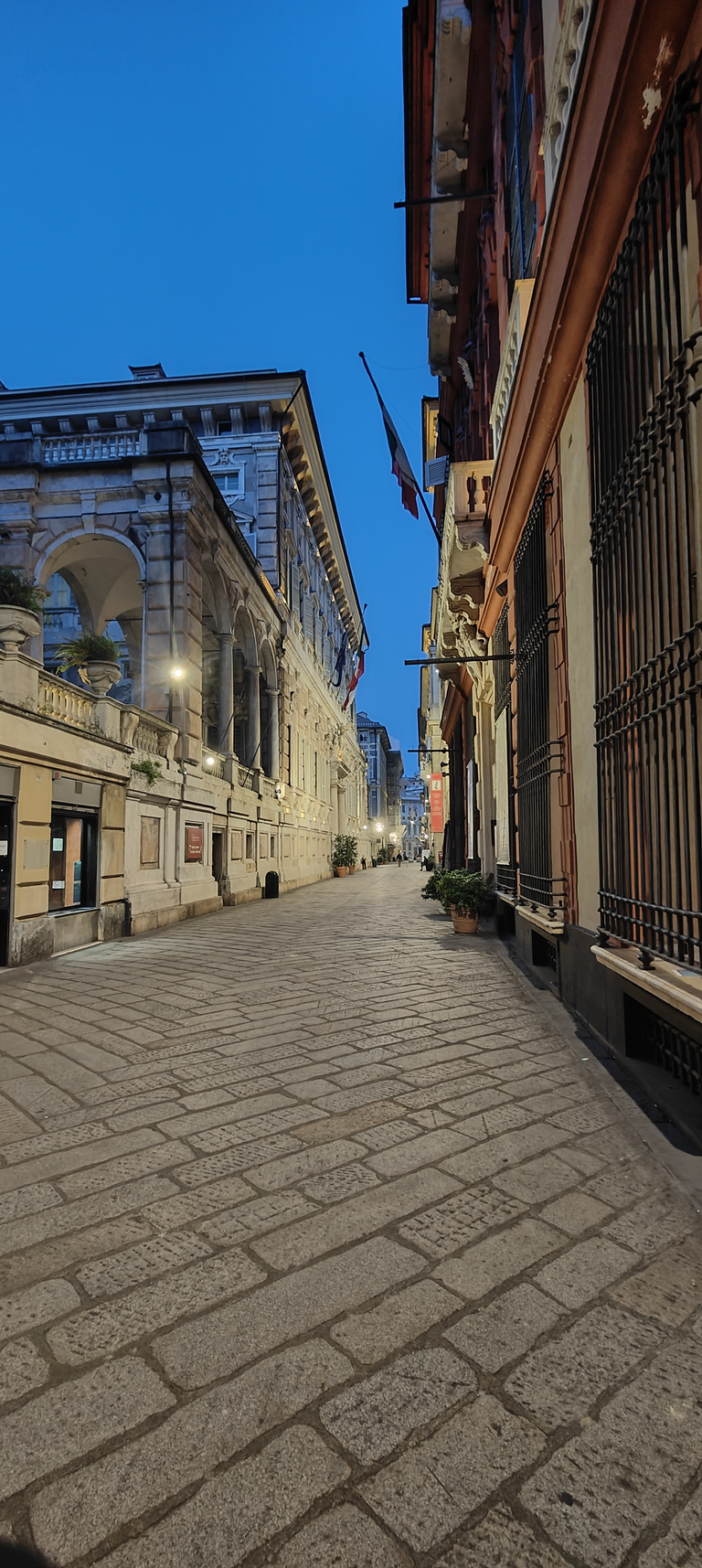
Rolli of Genoa originally called Rolli of the public lodgings of Genoa in the times of the ‘Superba’ were the lists of splendid residences of noble families who aspired to host high dignitaries in transit through Genoa on the occasion of state visits in the Old Republic. In later times, the grand palaces hosted important travellers who included the Ligurian capital in their grand tours. Today and then, the Rolli represent the best of the most prestigious palaces in the historic centre of Genoa, especially along the old ‘New’ streets Via Garibaldi, where the City Hall is located, Palazzo Tursi and Via Balbi, the University area. In 2006, 42 palaces inscribed in the Rolli di Genova were listed by Unesco as World Heritage Sites.
Los Rolli de Génova originalmente llamados Rolli de los alojamientos públicos de Génova en tiempos de la «Superba» eran las listas de espléndidas residencias de familias nobles que aspiraban a hospedar a altos dignatarios en tránsito por Génova con motivo de visitas de Estado en la Antigua República. En épocas posteriores, los grandes palacios acogían a importantes viajeros que incluían la capital ligur en sus grandes recorridos. Hoy y entonces, los Rolli representan lo mejor de los palacios más prestigiosos del centro histórico de Génova, especialmente a lo largo de las antiguas calles «Nuevas» Via Garibaldi, donde se encuentra el Ayuntamiento, Palazzo Tursi y Via Balbi, la zona universitaria. En 2006, 42 palacios inscritos en los Rolli di Genova fueron declarados Patrimonio de la Humanidad por la Unesco.
Here are some useful tips to help you enjoy your visit. / Algunos consejos útiles para gozar de la visita.
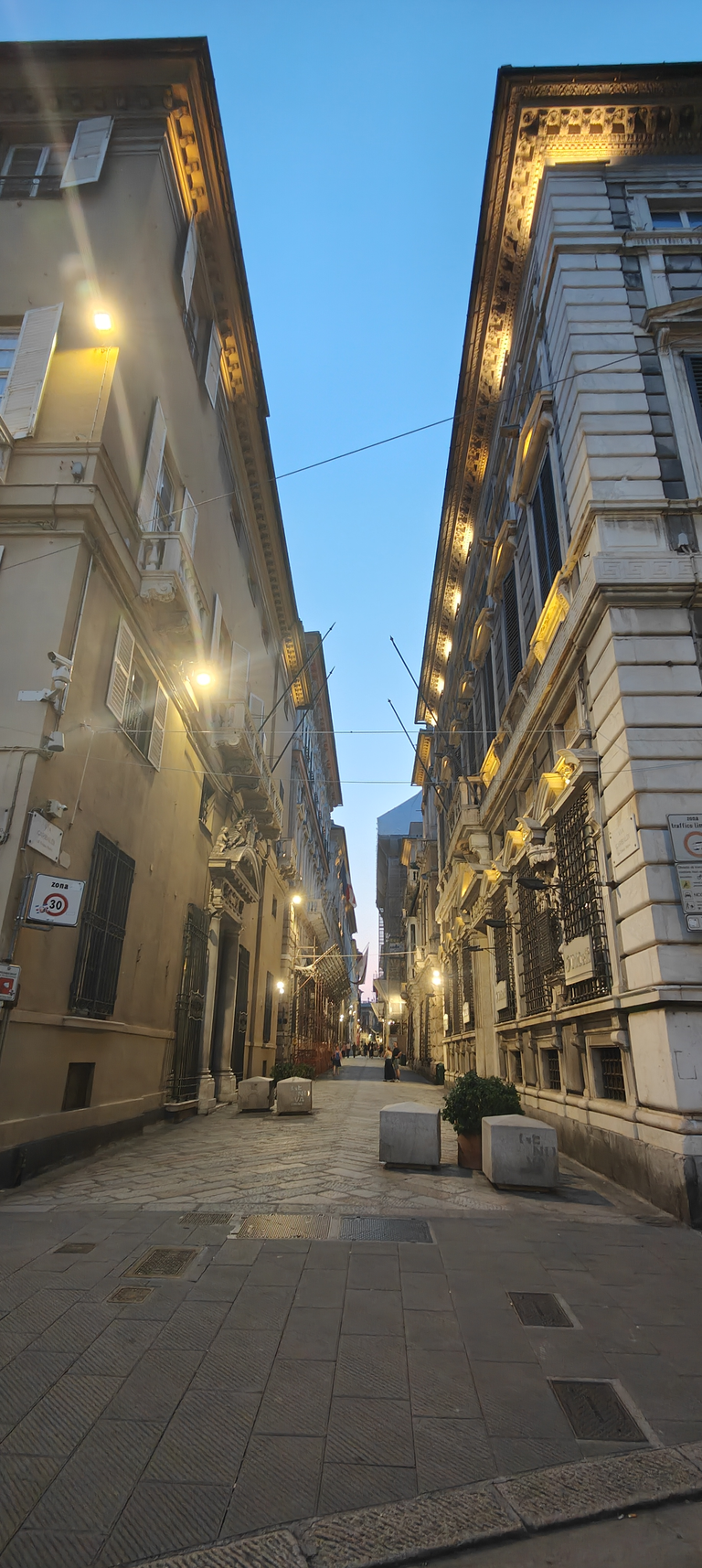
The best time to visit the Rolli is in spring and autumn, when Genoa celebrates its palaces: weekends when the buildings open their doors and show their treasures to the public.
Via Garibaldi is home to the valuable museum system of the Musei di Strada Nuova, which links three important Genoese palazzi: Palazzo Doria Tursi, Palazzo Bianco and Palazzo

El mejor momento para visitar los Rolli es en primavera y otoño, cuando Génova celebra sus palacios: fines de semana en los que los edificios abren sus puertas y muestran sus tesoros al público.
Via Garibaldi alberga el valioso sistema museístico de los Musei di Strada Nuova, que une tres importantes palacios genoveses: el Palazzo Doria Tursi, el Palazzo Bianco y el Palazzo Rosso.Rosso.
Via Garibaldi. / Calle Garibaldi.

The first example of subdivision at a European level, Via Giuseppe Garibaldi presents a stylistic and conceptual uniqueness that made it internationally famous even then. Peter Paul Rubens studied its buildings, and his drawings contributed to the spread of the Renaissance style in Northern Europe.
In reality, the initial construction was that of a new residential neighborhood for the great Genoese families who abandoned the medieval neighborhoods for a new lifestyle based on less contrast. The construction of the entire group of buildings lasted about forty years and the realization of the project is due to the very rich Grimaldi family who also acquired the largest area. The most infamous area of the city was transformed into the most privileged area and from a construction point of view, building problems related to building such a complex of buildings on the coast, above the port, were solved for the first time.
A plaque placed at the beginning of the artery defines the street as the model of social and economic identity that inaugurated the urban architecture of the modern age in Europe.
According to the motivation with which UNESCO included it among the world heritage sites, the influence that this urban and architectural heritage has exerted, so much so that it has become an example and reference for many countries, is at the same time testimony to a city - seventeenth-century Genoa - that was able to reach the peak of political and economic power on the continental level.
The plaque reads:
"[The street] preserves urban spaces from the late Renaissance and Baroque periods, flanked by over one hundred palaces of noble families of the city."
In the internal courtyard of Palazzo Rosso - as well as in the hanging garden of Palazzo Doria Tursi - theatrical performances and concerts are periodically held. Today, Via Garibaldi is home to - in addition to many public and private offices and several national and foreign banking institutions - two of the main art galleries and picture galleries of the city - Palazzo Rosso and Palazzo Bianco - which together with Palazzo Doria Tursi, the seat of the Municipality, constitute the Strada Nuova Museums.
The street was built in the second half of the 16th century - the one that will go down in history as El siglo de los Genoveses, the century of the Genoese - at the behest of the local aristocracy, who intended in this way to bring their residential neighborhood closer to the sea, compared to the hilly areas where it had been located until then. The planning and construction of most of its buildings lasted for about forty years, until 1588.

Primer ejemplo de urbanización a nivel europeo, Via Giuseppe Garibaldi presenta una singularidad estilística y conceptual que la ha hecho ya famosa internacionalmente. Peter Paul Rubens estudió sus palacios y sus dibujos contribuyeron a la difusión del estilo renacentista en el norte de Europa.
En realidad, la construcción inicial fue la de un nuevo barrio residencial para las grandes familias genovesas que abandonaron los barrios medievales por un nuevo estilo de vida basado en una menor oposición. La construcción de todo el conjunto de edificios duró unos cuarenta años y el proyecto fue llevado a cabo por la riquísima familia Grimaldi, que además adquirió la mayor superficie. La zona más infame de la ciudad se transformó en la más privilegiada y, desde el punto de vista constructivo, se solucionaron por primera vez los problemas de edificación relacionados con la construcción de un complejo de edificios de este tipo en la costa, encima del puerto.
Una placa colocada al inicio de la arteria define la calle como modelo de identidad social y económica que inauguró la arquitectura urbana de la era moderna en Europa.
Según la motivación con la que la UNESCO la incluyó entre los sitios de patrimonio mundial, la influencia que este patrimonio urbano y arquitectónico ha ejercido, tanto es así que se ha convertido en ejemplo y referencia para muchos países, es al mismo tiempo testimonio de una ciudad - la Génova del siglo XVII - que supo alcanzar la cima del poder político y económico a nivel continental.
La placa dice:
«[La calle] conserva espacios urbanos de finales del Renacimiento y del Barroco, flanqueados por más de cien palacios de familias nobles de la ciudad.»
Periódicamente se celebran representaciones teatrales y conciertos en el patio interior del Palazzo Rosso, así como en el jardín colgante del Palazzo Doria Tursi. Hoy en día, en Via Garibaldi se encuentran, además de numerosas oficinas públicas y privadas y varias instituciones bancarias nacionales y extranjeras, dos de las principales pinacotecas y galerías de arte de la ciudad: el Palazzo Rosso y el Palazzo Bianco, que junto con el Palazzo Doria Tursi, sede del Ayuntamiento, constituyen los Museos de la Strada Nuova.
La calle fue construida en la segunda mitad del siglo XVI -lo que pasará a la historia como El siglo de los Genoveses- a instancias de la aristocracia local, que pretendía de esta forma acercar su barrio residencial al mar, frente a las zonas montañosas en las que se ubicaba hasta entonces. La planificación y construcción de la mayoría de sus edificios tomó alrededor de cuarenta años, hasta 1588.
e Strade Nuove and the system of the Rolli palaces in GenoaLas Strade Nuove (Calles Nuevas y el sistema de los palacios Rolli en Génova.
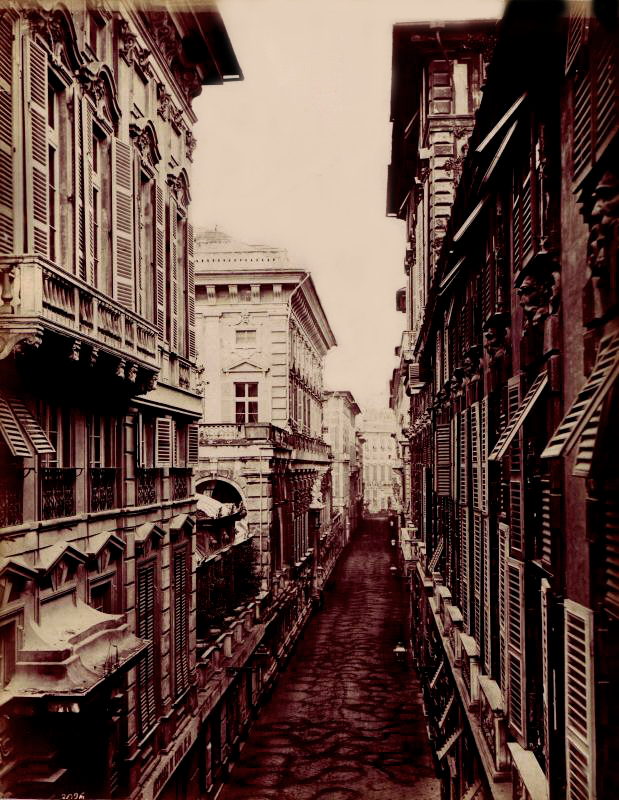
The Strade Nuove and the system of the Rolli palaces is a UNESCO World Heritage site located in the historic center of Genoa (Liguria, Italy).
The Strade Nuove (Via Giuseppe Garibaldi, formerly Strada Nuova or Via Aurea, Via Cairoli, formerly Strada Nuovissima, via Bensa and via Balbi) are a group of streets built by the Genoese aristocracy between the second half of the sixteenth century and the first half of the seventeenth century, when the Republic of Genoa was at the height of its maritime and financial power.
The Rolli palaces are a group of noble palaces that, at the time of the ancient Republic, were obliged, on the basis of a public draw from the lists of public lodgings (called "rolli"), to host the high personalities who were in Genoa on state visits. They include a series of late Renaissance and Baroque buildings that typically have three or four floors "with spectacular open staircases, courtyards and loggias overlooking gardens"[2]. Many of the interiors, despite the passing of the centuries and the heavy damage due to the bombings of Genoa in the Second World War,[3] feature the original decorations of the major authors of Genoese Mannerism and Baroque. In later periods, the same homes hosted illustrious travellers who included the Ligurian capital in their Grand Tour.

Las Strade Nuove (calles nuevas) y el sistema de los Palacios Rolli es un sitio incluido en el Patrimonio de la Humanidad de la UNESCO situado en el centro histórico de Génova (Liguria, Italia).
Las Strade Nuove (Via Giuseppe Garibaldi, antigua Strada Nuova o Via Aurea, Via Cairoli, antigua Strada Nuovissima, Via Bensa y Via Balbi) son un conjunto de calles construidas por la aristocracia genovesa entre la segunda mitad del siglo XVI y la primera mitad del siglo XVII, cuando la República de Génova estaba en el apogeo de su poder marítimo y financiero.
Los palacios Rolli son un grupo de palacios nobiliarios que, en la época de la antigua República, estaban obligados, mediante un sorteo público realizado en las listas de alojamientos públicos (llamados "rolli"), a hospedar a personalidades de alto rango que se encontraban en Génova en visita de Estado. Incluyen una serie de edificios de finales del Renacimiento y del Barroco que suelen tener tres o cuatro pisos "con espectaculares escaleras abiertas, patios y logias con vistas a los jardines"[2]. Muchos de los interiores, a pesar del paso de los siglos y de los graves daños debidos a los bombardeos sobre Génova durante la Segunda Guerra Mundial,[3] conservan las decoraciones originales de los principales autores del manierismo y del barroco genovés. En épocas posteriores, las mismas casas acogieron a ilustres viajeros que incluyeron la capital ligur en su Grand Tour.
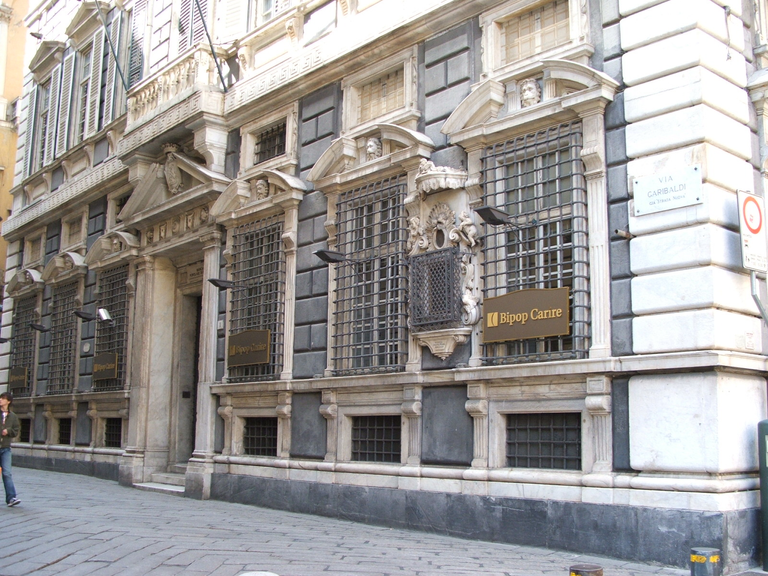
Source images / Fuente imágenes.



L'italia è sempre Bellissima!
Senza dubbio. Una volta all'uscita dell'aeroporto un turista mi ha detto: "La verità è che la natura ha dato tutto all'Italia" Aveva ragione.
Buon fine settimana!